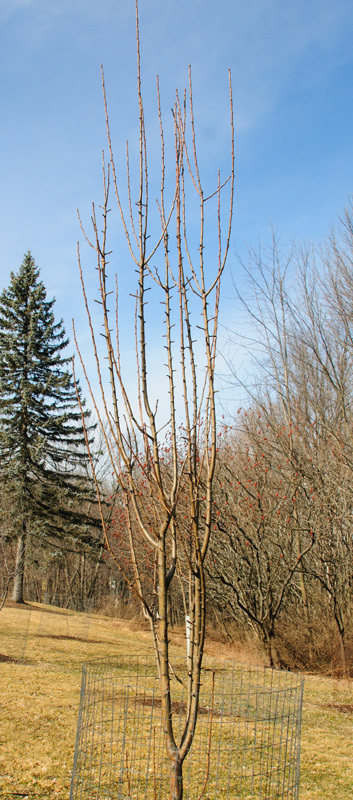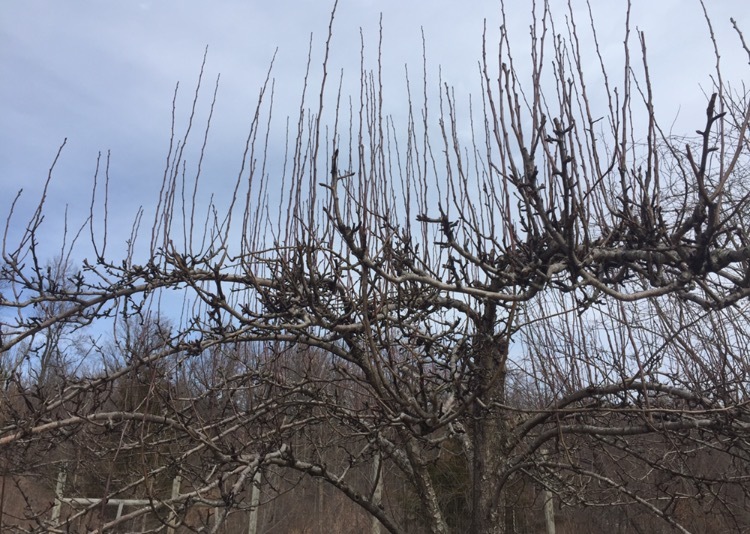I have a request from a backyard grower to prune his apple trees…no problem there but he also wants this pear tree pruned. Can anyone make some suggestions as to what has to be cut, if anything ? Remove any verticles completely ?Some of those verticles are 1.5 inches in diameter.
Should those whippy tops be headed back ? thanx, geo

See R.S. Martin’s “How To Prune Fruit Trees”
I can’t really help you that much as I’m dealing with a similar problem on a couple mature pear trees that were established when I bought the property, namely, the desire to go straight up. I’d guess that’s going to be your biggest challenge – keeping the trees low and more horizontal. On my trees I have some beautiful curved branches coming off the trunk, but every year they get lined by water sprouts across the entire 5 foot length. The tree ends up looking like a giant candelabra!
You might be able to bend some of the branches down and tie them so they open up the center of the tree and lower the fruiting area. (as I say that, I realize it’s hard to tell how close to the ground the main fork is, but for some reason I assumed your cage is 4 ft tall).
Humm, that photo showed up on my phone but I can’t see it on my computer monitor.
Here’s a second try.
Unsuccessful again. This time I’m going to take a photo of the photo and try that. I’m thinking maybe the file size is too big? (On the other hand they both appear on my phone)
Can the rest of you see all three photos?
I just check another thread I successfully posted a photo in, and I can no longer see it on my PC. It was visible to me at one point, but not any longer, so I’m thinking the view problem is on my end only.
Scott - feel free to delete some or all of these posts!!!
Pears are so ugly. Just straight up. But after 10 yrs mine have settled down and aren’t nearly as ugly. Good luck to anyone pruning pears!!
All of the upward growth are water spouts, and I prune them out every year.
They make great scion wood. If you don’t prune them. you’re going to get fruit
20-30 ft.up in the air. Good luck in harvesting them.
New pear trees are no problem training to central leader…it’s when you come up against an older tree that was never previously trained that is the PITA.
I think on my problem tree most of the upright/verticles are too far along to bend/spread. Some maybe.
I’m going to do something but haven’t worked up the nerve just yet…do not want a 40 foot tree. thanx, geo.
I would remove the two lower limbs that go towards the right, perhaps using a Dutch cut on one of them to encourage a shoot from the stub if you want to try to train a scaffold at that point. Look for scaffold branches above, and train them out with twine or weights. Basic rules of removing inward growing or crossing branches, doesn’t look like there’s many of those though.
I guess Asian Pears are in the same category. They just want to grow straight up. I tried training them (tying them to a brick) and the new branches still want to grow vertical. After taking the ties off, the new branches end up facing inward!
I’ve had much better luck keeping my Asian pears small and horizontal, but I planted them all myself, bareroot. The one thing that I’ve been doing on them religiously, is breaking off any and all water sprouts when I see them no matter what time of year. I try to get them as soon as I can (less than 6 inches tall and usually about half that size) and they come off cleanly by just pulling them. No pruners needed. They just snap off very easily.
Bart,
I would think you need to save some for future fruit-woods? I have 3 Asian pears that are bearing for the past 2 years and 2 more that will be coming online next year. At this moment, I’m still a little loss of what to do. I did pruned them “heartlessly” last week but kind of doubt myself along the process and a bit worried though…
I think Jesse is right on. Your neighbor essentially has three trees on one root, and you have to get it down to the best one. I hadn’t thought of the dutch cut though, but I think it’s a great idea. You might be able to encourage buds on the trunk to grow by notching above them.
I’ve never tried it, but it occurs to me that any (or all!) of the three competing leaders might be brought to a more horizontal level using Alan’s technique of cutting kerfs partway into them, but as I said I’ve never tried it.
I’d head it back if only because it’ll keep growing to the sky! I keep my one pear to about 12 feet and that’s plenty high enough.
Thank you all. I’m teaching a class tomorrow on pruning young apple trees, which are fairily easy. After the class leaves I think I’ll pull up a chair to that pear tree and think about how to attack the pruning of it. Thanx again for the suggestions… geo.
The challenge is always cutting away the oversized scaffolds. Sometimes you knock the tree out of balance for a while but you need to bite the bullet. The next challenge is leaving enough upright wood- usually there are enough less vigorous uprights to serve the cycle of spur wood. Out with the old- in with the new.
Without spreaders you have to be tricky- you can tape higher branches to lower ones to spread them but why not order some 12" and 18" Treeform spreaders. http://www.peachridge.com/treetraining/training.htm
There is no reason to be held hostage to some varieties of pears upright habit.
Cutting into one year wood creates a vegetative response (unless you wait to summer). Cutting into older wood reduces vigor. Spreading branches reduces vigor and encourages fruiting.
Pears are not so difficult but they don’t at all grow the same between varieties. Bosc is a crazy grower sending out drooping shoots all over the place. Bartlett has a bit of this tendency but not nearly as much. Seckel and Harrow Sweet are very cooperative.
Bosc is the only pear that I will cut back annual shoots to stiffen them up and make them grow straight.
I am sorry for my inability to offer a step by step guide to rebuilding a neglected pear tree but the most important thing is to have the courage to remove the “bad” wood. You need to determine the straightest leader and remove its competition- anything more than half the diameter of your chosen leader at the point of attachment to that leader.
Alternatively you can spread the competition horizontally (as long as it isn’t thicker than your leader) and go after uprights coming off it during the next 3 growing seasons or so and you may manage to subdue it.
Thanx Alan…glad to hear that about Harrow Sweet as I have a bare root one coming from Cummins for my own little 1/2 acre, along with a Harrow Gold.
Alan has the right idea. I’d wack the tree heavily and use a combination
of limb spreaders and weights, in order to train the tree into more of an
open vase system with lateral growth.
I see all three. Bill

